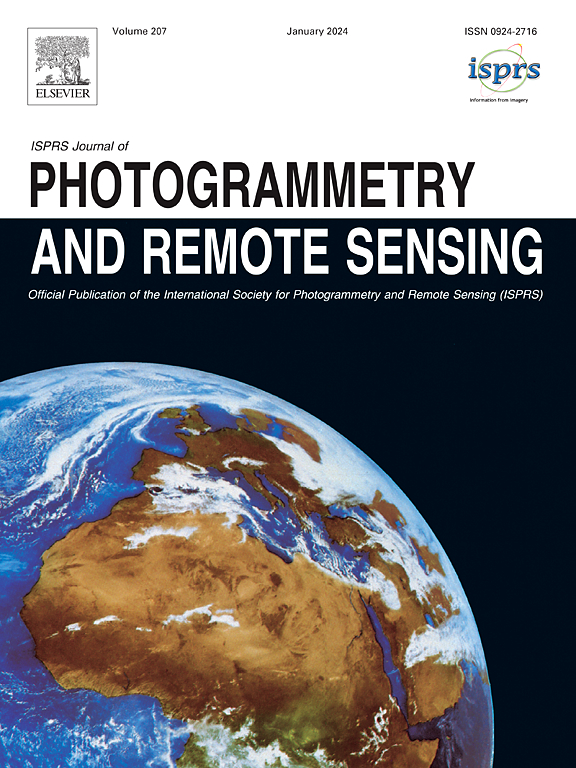基于焦平面偏振分割的三维结构光重建高精度水下浊度去除
IF 12.2
1区 地球科学
Q1 GEOGRAPHY, PHYSICAL
ISPRS Journal of Photogrammetry and Remote Sensing
Pub Date : 2025-07-26
DOI:10.1016/j.isprsjprs.2025.07.023
引用次数: 0
摘要
随着海洋技术的快速发展,水下三维结构光重建已经成为海洋探测、海洋机器人和水下装配的关键工具。然而,水环境中通常含有大量的悬浮粒子,这些悬浮粒子会散射和吸收来自目标的信号光,从而降低水下图像的质量,导致传统的基于图像的三维重建方法效果不理想。为了解决这一挑战,我们开发了一种具有偏振成像的时间复用结构光系统,以获得密集而准确的目标几何信息。随后,我们提出了基于该系统的水下除浊网络。该网络减轻了水下浑浊对成像精度和质量的影响,显著提高了三维重建的精度和有效性。首先,我们建立了一个偏振系统,在四个不同的偏振角度捕捉水下物体的条纹图像。通过计算第二Stokes参数和偏振度,结合Canny特征作为全局轮廓捕获块的输入,有效提取目标轮廓信息,沿目标边缘恢复条纹边界。此外,我们引入了条纹捕获块来细化条纹图案的边界,从而获得更清晰的物体内部重建。通过利用全局轮廓捕获块和条纹捕获块,实现了高精度的水下结构光重建。大量的实验结果表明,我们的模型在PSNR、SSIM和LPIPS方面取得了出色的表现,分别达到21.226、0.969和0.050,显著优于现有方法的重建精度。本文章由计算机程序翻译,如有差异,请以英文原文为准。
High-precision underwater turbidity removal for 3D structured light reconstruction using division-of-focal-plane polarization
With the rapid advancement of marine technology, underwater 3D structured light reconstruction has emerged as a pivotal tool for ocean exploration, marine robotics, and underwater assembly. However, the aquatic environment typically contains numerous suspended particles that scatter and absorb signal light from the target, degrading underwater image quality and leading to unsatisfactory results with traditional image-based 3D reconstruction methods. To address this challenge, we have developed a temporal-multiplexing structured light system with polarization imaging to obtain dense and accurate target geometry information. Subsequently, we propose an underwater turbidity removal network based on this system. This network mitigates the impact of underwater turbidity on imaging accuracy and quality, significantly enhancing the precision and effectiveness of 3D reconstruction. Initially, we built a polarization system to capture fringe images of underwater objects at four different polarization angles. By calculating the second Stokes parameter and the degree of polarization, and then combining Canny features as input for the global contour capture block, we effectively extract the object’s contour information, restoring the fringe boundaries along its edges. Additionally, we introduce a fringe capture block to refine the boundaries of the fringe patterns, resulting in clearer internal reconstructions of the objects. By leveraging both the global contour capture block and the fringe capture block, we achieve high-precision underwater structured light reconstruction. Extensive experimental results demonstrate that our model achieves outstanding performance in terms of PSNR, SSIM, and LPIPS, with scores of 21.226, 0.969, and 0.050, respectively—significantly outperforming the reconstruction accuracy of state-of-the-art methods.
求助全文
通过发布文献求助,成功后即可免费获取论文全文。
去求助
来源期刊

ISPRS Journal of Photogrammetry and Remote Sensing
工程技术-成像科学与照相技术
CiteScore
21.00
自引率
6.30%
发文量
273
审稿时长
40 days
期刊介绍:
The ISPRS Journal of Photogrammetry and Remote Sensing (P&RS) serves as the official journal of the International Society for Photogrammetry and Remote Sensing (ISPRS). It acts as a platform for scientists and professionals worldwide who are involved in various disciplines that utilize photogrammetry, remote sensing, spatial information systems, computer vision, and related fields. The journal aims to facilitate communication and dissemination of advancements in these disciplines, while also acting as a comprehensive source of reference and archive.
P&RS endeavors to publish high-quality, peer-reviewed research papers that are preferably original and have not been published before. These papers can cover scientific/research, technological development, or application/practical aspects. Additionally, the journal welcomes papers that are based on presentations from ISPRS meetings, as long as they are considered significant contributions to the aforementioned fields.
In particular, P&RS encourages the submission of papers that are of broad scientific interest, showcase innovative applications (especially in emerging fields), have an interdisciplinary focus, discuss topics that have received limited attention in P&RS or related journals, or explore new directions in scientific or professional realms. It is preferred that theoretical papers include practical applications, while papers focusing on systems and applications should include a theoretical background.
 求助内容:
求助内容: 应助结果提醒方式:
应助结果提醒方式:


